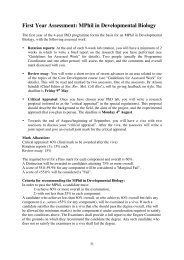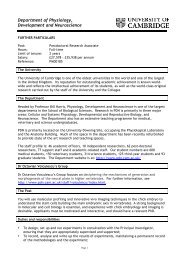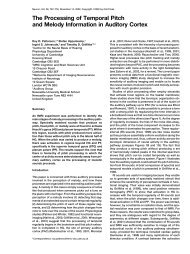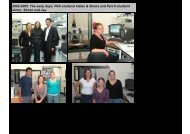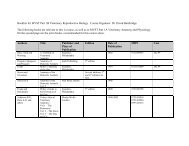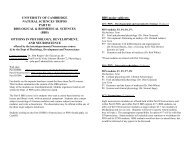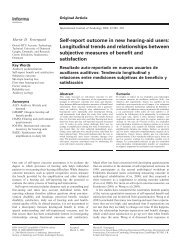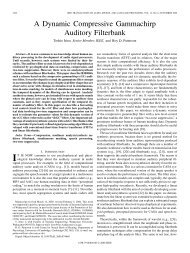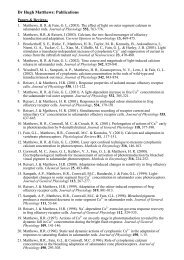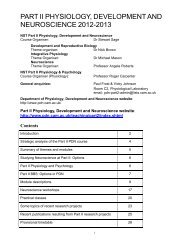FRIDAY MORNING, 20 MAY 2005 REGENCY E, 8:30 A.M. TO 12:00 ...
FRIDAY MORNING, 20 MAY 2005 REGENCY E, 8:30 A.M. TO 12:00 ...
FRIDAY MORNING, 20 MAY 2005 REGENCY E, 8:30 A.M. TO 12:00 ...
Create successful ePaper yourself
Turn your PDF publications into a flip-book with our unique Google optimized e-Paper software.
esults, the feasibility of performing real-time adaptive environmental assesment<br />
using AREA under realistic ocean conditions will be discussed.<br />
Work supported by ONR.<br />
2:<strong>30</strong><br />
5pUW5. Optimizing multistatic sonobuoy placement. Donald R.<br />
DelBalzo, Erik R. Rike, and David N. McNeal Neptune Sci. Div. of<br />
Planning Systems, Inc., 40<strong>20</strong>1 Hwy 190 E, Slidell, LA 70461,<br />
delbalzo@neptunesci.com<br />
Sonobuoy patterns for monostatic sensors were developed during the<br />
Cold War for deep, uniform underwater environments, where a simple<br />
median detection range defined a fixed inter-buoy spacing usually along<br />
staggered lines. Oceanographic and acoustic conditions in littoral environments<br />
are so complex and dynamic that spatial and temporal variability<br />
of low-frequency signal and noise fields destroys the basic homogeneous<br />
assumption associated with standard tactical search concepts. Genetic Algorithms<br />
GAs have been applied to this problem to produce nearoptimal,<br />
non-standard search tracks for monostatic mobile sensors that<br />
maximize probability of detection in such inhomogeneous environments.<br />
The present work describes a new capability, SCOUT Sensor Coordination<br />
for Optimal Utilization and Tactics, to simulate multistatic<br />
distributed-sensor geometries and to optimize the locations of multistatic<br />
active sonobuoys in a complex, littoral environment. This presentation<br />
reviews the GA approach, discusses the new chromosome structure, and<br />
introduces a new target-centric geometry. The results show that a standard<br />
patterns are not optimal even for a homogeneous environment, b<br />
small distributed sensor clusters are preferred, and c standard patterns<br />
are grossly ineffective in inhomogeneous environments where <strong>20</strong>% improvements<br />
in detection are achieved with SCOUT. Work supported by<br />
NAVAIR.<br />
2:45<br />
5pUW6. Acoustic particle velocity and intensity calculations from<br />
tri-axial pressure gradient measurements. Melanie E. Austin and Alex<br />
O. MacGillivray JASCO Res. Ltd., 2101-4464 Markham St., Victoria,<br />
BC, Canada V8Z 7X8, melanie@jasco.com<br />
In July <strong>20</strong>04 Fisheries and Oceans Canada supported a study to investigate<br />
effects of seismic airgun signals on hearing organs of freshwater fish<br />
in the Mackenzie River at Inuvik, NWT Canada. The study required particle<br />
velocity measurements for correlation with observed biological effects.<br />
JASCO Research built a pressure gradient measurement apparatus<br />
consisting of four hydrophones mounted at the vertices of a triangularpyramid<br />
frame. The system was used to measure differential pressure from<br />
the airgun events simultaneously in three perpendicular axial directions.<br />
An attached depth-compass sensor monitored the depth and orientation of<br />
the system. Hydrophone separations were chosen to be small relative to<br />
the acoustic wavelength so that measured differential pressures correctly<br />
approximated the pressure gradients along each axis. Particle accelerations<br />
were computed directly from pressure gradients following Euler’s linearized<br />
momentum equation, and particle velocities were computed by integrating<br />
particle accelerations. Acoustic intensity was computed from the<br />
product of acoustic pressure and particle velocity. The hydrophone precision<br />
imposed a limit on accuracy of particle velocity measurements at low<br />
frequencies. Likewise the fixed hydrophone spacings defined an upper<br />
frequency limit for applicability of this method.<br />
3:<strong>00</strong><br />
5pUW7. Macroscopic sonic crystals in a wave guide. Dalcio K. Dacol,<br />
Gregory J. Orris, and David C. Calvo Acoust. Div. Naval Res. Lab.,<br />
Washington, DC <strong>20</strong>375-5350<br />
Periodical arrays of long, parallel cylinders have been shown in the<br />
published literature to exhibit acoustical properties which are analogous to<br />
the electronic properties of certain crystalline solids. Thus there are frequency<br />
bands for which no acoustic propagation through the array is allowed,<br />
with those band gaps being directionally dependent. The properties<br />
of such arrays in wave guides are examined in this work. Particular emphasis<br />
is put in investigating the properties of those arrays in wave guides<br />
that are idealized models of shallow water oceanic wave guides. The effects<br />
of those arrays on the propagation of normal modes is investigated in<br />
detail. The possibility of using such arrays in the construction of large<br />
scale underwater devices such as filters and lenses is also discussed. Work<br />
supported by ONR.<br />
2625 J. Acoust. Soc. Am., Vol. 117, No. 4, Pt. 2, April <strong>20</strong>05 149th Meeting: Acoustical Society of America 2625<br />
5p FRI. PM



